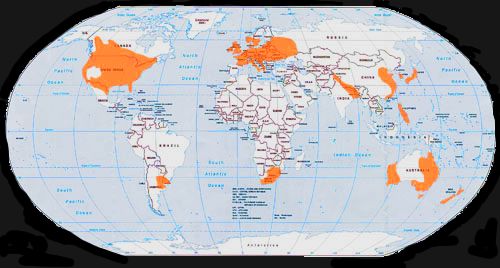 |
 |
| Home | Welcome | What's New | Site Map | Glossary | Weather Doctor Amazon Store | Book Store | Accolades | Email Us |
 | |||||||||||||||||||||||||||||||||||||||
Weather Almanac for June 2007FOREIGN TORNADOES
In fact, many articles on tornadoes, even those on the global view, pass off tornadoes outside North America with a phrase similar to this one: "Other locations that experience frequent tornado occurrences include northern Europe, western Asia, Bangladesh, Japan, Australia and New Zealand." There is no doubt that the US, by far, reports the most tornadoes annually of any country in the world, perhaps three quarters to two thirds of the world's tornadoes occur in the United States. But, in fact, on a tornado-occurrences-per-square-mile scale, the United Kingdom rates as the most tornado-struck country in the world. In this overview of foreign tornadoes (foreign meaning here those not striking the US or Canada), I will summarize what I could find in the literature available to me on the frequency of tornadoes and major tornado events in the remaining portions of the globe. Enhancements in the ability to spot tornadoes — increased reports from storm chasers, local officials, the media, and the public; improved radar detection; increased population densities in tornado prone regions; and public interest in these storms — have increased the number of storms reported in the US and other nations over the past two to three decades. While some of the increase in numbers may be due to climatic changes and other weather cycles, the major cause of the increase in absolute numbers, I believe, is the greater diligence in looking for such storms in severe weather events. In sheer numbers, the US rates Number 1, suffering more than 1,000 tornadoes per year (as reported in the last decade or so). In a study by Harold Brooks and Charles A. Doswell III on the climatology of international tornado damage, they found decent tornado records for about nine nations over a quite variable record length. While most counted only tornadoes during parts of the 20th century, the French and German records covered hundreds of years. I constructed the following table from the Appendix of their report: Some aspects of the international climatology of tornadoes by damage classification. I rank the nations by the number of tornadoes reported with an F-scale rating.
Not included in this table are tornado statistics from the Netherlands, Spain, Russia, India, Bangladesh, China and Japan where tornadoes are known to be common (at least several reported per year). Europe as a whole experiences many tornadoes each year, 300 or more reported, perhaps double that in reality.
The current available numbers of annual tornadoes gleaned from the literature ranks the remaining nations as among the most prone. (Note European tornado estimates are for land tornadoes only; other nations may include waterspouts in their totals.) The United Kingdom averages 33 tornadoes per year (though the number might be closer to 100 according to a recent estimate by University of Leeds researchers). South Africa and Argentina both observed about 32 tornadoes per year. Australia tallies 20 tornadoes annually, but that too may be a vast underestimation. Based on observations, The Netherlands, New Zealand and Japan also report twenty tornadoes on average each year. The following map shows the distribution of highest tornado risk across the globe.  Map courtesy US National Climatic Data Center, NOAA.Many of the most tornado-prone regions are found in a latitude belt poleward of 25 degrees latitude to about 45 degrees, with the main exception being northern Europe, and are characterized by flat terrain. Deaths attributed to tornadoes are another way to look at the disaster potential of tornadoes, though such numbers must be looked at with population densities, building materials, and storm-warning programs in mind. The United States leads Tom Grazulis' list of top ten countries for total tornado deaths during the last century. Bangladesh follows second, then Russia, India, Canada, Italy, South Africa, France and Argentina. Grazulis suggest China may slip in ahead of Canada but data from that nation are sparse for much of the century. Note that often the media will report a tornado occurrence (or other weather event) in some part of the world as a rare event. Most often, writers of such a pieces have not done the proper research and call it rare because they have never heard of such thing (or that rare sells the piece to readers). In any natural event occurrence, the standard definition of rare is an event that occurs "no more frequently than once per hundred years." Discussions of tornadoes for the remaining five continents are given elsewhere on this site: Tornadoes of Europe
|
|||||||||||||||||||||||||||||||||||||||
 |
To Purchase Notecard, |
Now Available! Order Today! | |
 |
 |
NEW! Now |
The BC Weather Book: |


